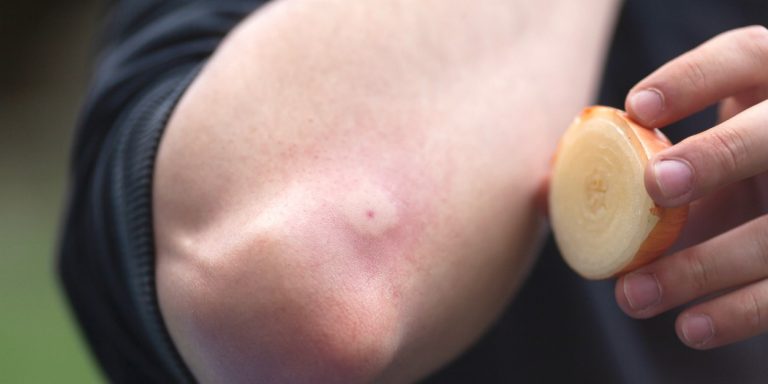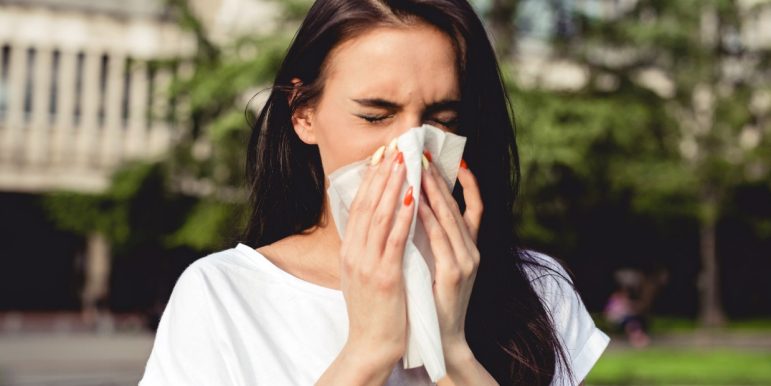
Bee sting: what should I do?
Bee stings are unpleasant and painful. It is particularly dangerous when the person suffers an allergic reaction. Here’s what you need to do.
Bees and wasps are especially active in summer. Sweet perfume, scented sunscreen, food aromas and bright colours all attract the insects. If they feel threatened, they sting. This is their way of defending themselves. The sting site generally becomes swollen and itches.
If the sting with the venom sac is still in the skin, it was a bee. Bees have a barbed stinger, which remains lodged in the skin. It is different with wasps, as they don’t lose their stings and so can in fact sting several times.
How to treat a bee sting properly
Remove the sting as quickly as possible. Either use tweezers or pull it out with your fingers, but be careful to not squeeze the venom sac as this will push more of the poison into the wound.
Do not be tempted to suck the venom out. It will enter the body even more quickly through the mucous membranes.
Cool down the affected area with ice cubes, cold water or a cooling gel. This will ease the pain and swelling. Antihistamine creams or tablets can also help reduce inflammation. Do not scratch the sting site, as this will open it up to bacteria. Call an emergency doctor if the sting is in the neck, mouth or throat area. Even without an allergic reaction, any swelling in these areas can be life-threatening, because severe swelling will block the airways.
Tip: warm a spoon and press it onto the sting site. The heat will denature the protein in the bee’s venom, reducing its effect. This can ease itching and swelling. However, make sure the spoon is not too hot or you will risk burning the skin.
Allergic reaction to a bee sting
In Switzerland, between 3% and 4% of the population suffers from an insect venom allergy. If these people are stung by a bee, this triggers an allergic reaction and in the worst case anaphylactic shock. The symptoms differ depending on the severity of the reaction.
- Reddening
- Itching (local reaction or whole body)
- Swelling
- Severe pain
- Hives
- Vomiting
- Heart palpitations
- Drop in blood pressure
- Circulatory collapse
- Fainting
- Respiratory arrest
Those with allergies will have been given an emergency kit with drugs (antihistamines, cortisone and adrenaline) by their doctor. These drugs ease the allergic reaction and stabilise the circulatory system.
An insect venom allergy can be cured with desensitisation (hypo-sensitisation), a treatment that takes between three and five years. Hypo-sensitisation involves exposing patients to ever larger doses of the allergen (bee venom). The aim of the treatment is to help the body get used to the bee venom, so it develops an immune tolerance to it. This should then prevent allergic reactions in future.
Household remedies for bee stings
- Cold vinegar compress
- Compress with acetic clay solution
- Sliced onion
How to prevent bee stings
Avoid strongly-perfumed shampoo and hairspray or scented sunscreen. Do not walk barefoot. Avoid floaty loose clothing. Wear long sleeves and trousers as well as gloves when gardening. Avoid sudden movements. Do not leave uncovered food or drinks standing around.


Newsletter
Find out more about current health issues every month and get all the information you need about our attractive offers from all Helsana Group companies * delivered by e-mail to read whenever it suits you. Our newsletter is free of charge and you can sign up here:
We did not receive your information. Please try again later.
* The Helsana Group comprises Helsana Insurance Company Ltd, Helsana Supplementary Insurances Ltd and Helsana Accidents Ltd.